Anchored by two important cultural institutions — the Museum of Contemporary Art, Taipei (台北當代藝術館) and SPOT Taipei Film House (台北光點) — the neighborhood around the Zhongshan MRT Station (中山捷運站) is home to some of the country’s top designers and artists.
Zhongshan North Road features exclusive boutiques, including Shiatzy Chen’s (夏姿) flagship store at 49-1, Zhongshan Rd Sec 2 (中山北路二段49-1號), but the lanes and alleys around the MRT station are filled with smaller independent boutiques selling affordable items by emerging designers that range from clothing to ceramics. Read on for a few of the area’s highlights.
61Note
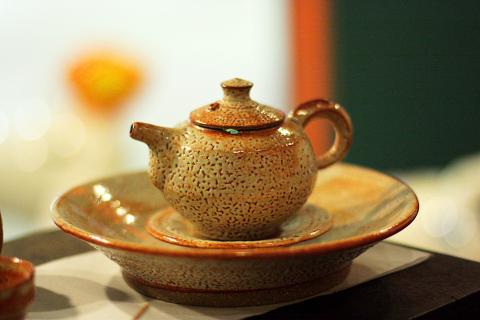
Photo: Catherine Shu, Taipei Times
Address: 6, Alley 10, Ln 64, Nanjing W Rd, Taipei City (台北市南京西路64巷10弄6號)
Telephone: (02) 2550-5950
On the Net: 61note.blogspot.com
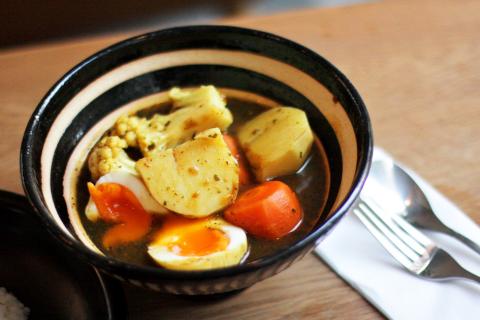
Photo: Catherine Shu, Taipei Times
61Notes’s corner space is home to a tiny cafe, a basement gallery space and a shop selling a carefully picked selection of quality kitchenware, stationery and bags that have a minimalist aesthetic and are handmade by Taiwanese and Japanese designers.
MBmore (岩筆模)
Address: Zhongshan Metro Mall B39 (台北捷運中山地下街B39), near exit R9 between Zhongshan and Shuanglian (雙連) MRT stations
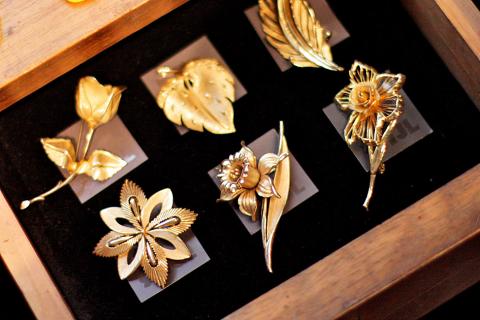
Photo: Catherine Shu, Taipei Times
Telephone: (02) 2523-7737
On the Net: mbmore1024.blogspot.com
Located in Zhongshan Metro Mall, MBmore sells work by more than 40 Taiwanese print artists. Founded by artist Lin Ren-hsin (林仁信), MBmore also hosts workshops and exhibitions. Original artwork from Taiwanese artists is sold in MBmore, but there are also plenty of affordable limited edition and signed prints starting from NT$300. Other items for sale include silk-screened canvas totes and individual lead type from Ri Xing Typography (日星鑄字行).
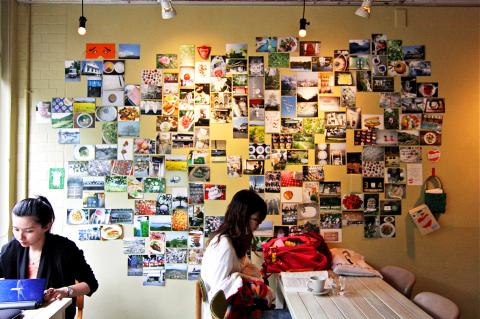
Photo: Catherine Shu, Taipei Times
De Stijl (識得)
Address: 20, Ln 33, Chifeng St, Taipei City (台北市赤峰街33巷20號)
Telephone: (02) 2552-7725
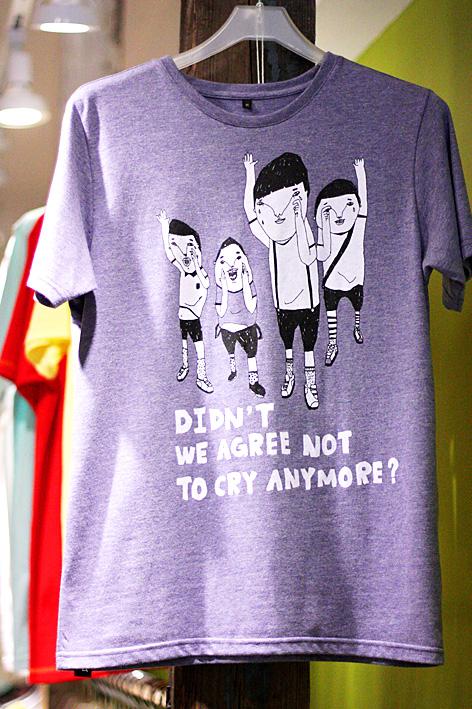
Photo: Catherine Shu, Taipei Times
On the Net: www.destijl.com.tw
Opened by collector Eli Hsieh (謝慶良), De Stijl carries a carefully curated selection of vintage American and European art deco, art nouveau and modernist jewelry. The store also has an impressive selection of unusual sterling silver charms, many of which have moving parts. Current examples in the store include a tiny sterling silver ship in a glass bottle and a wedding cake that lifts open to reveal a bride and groom.
Wu Xing Design Company (五行創藝設計)
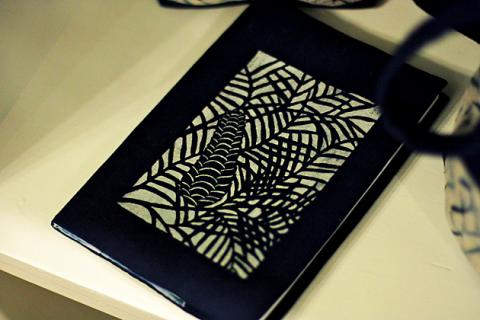
Photo: Catherine Shu, Taipei Times
Address: Zhongshan Metro Mall B41 (台北捷運中山地下街B41)
Telephone: (02) 2625-1498
On the Net: www.wxad.com.tw
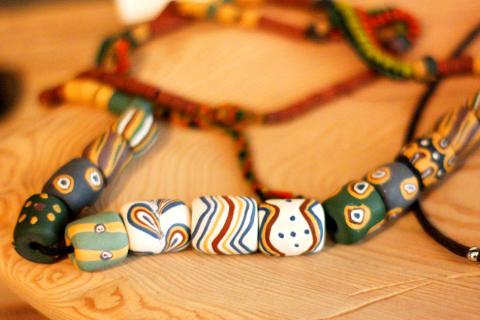
Photo: Catherine Shu, Taipei Times
MBmore’s next-door neighbor, Wu Xing, is comanaged by the National Taiwan University of Arts (國立臺灣藝術大學) and gives a platform to Taiwanese ceramic artists and jewelry makers. A shelf that features handmade mugs in a beautiful array of textures, glazes and finishes takes up one wall, while a case is filled with exquisitely crafted sterling silver jewelry in contemporary designs.
Booday (蘑菇)
Address: 18-1, Ln 25, Nanjing W Rd, Taipei City (台北市南京西路25巷18-1號)
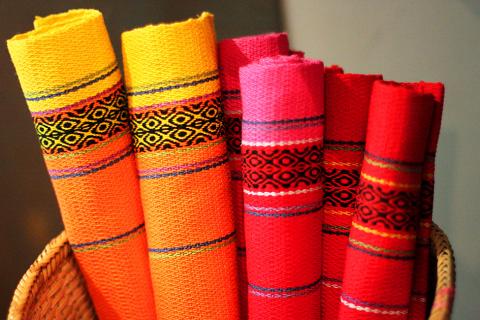
Photo: Catherine Shu, Taipei Times
Telephone: (02) 2552-5552 X11
On the Net: www.mogu.com.tw; haveaboodayshop.blogspot.com
In the past eight years Booday (蘑菇) has grown from a small graphics design firm into one of Taiwan’s best-known lifestyle brands. Its building a few blocks away from Zhongshan MRT station still retains a sense of intimacy, however, with a sunny second-floor cafe and a small boutique filled with Booday’s own wares and items from Taiwanese and Japanese artists and designers. The brand’s signature is its careful attention to details such as the soft texture of its organic T-shirts and hand-illustrated designs that use motifs from daily life in Taiwan. The cafe also regularly hosts live music performances, workshops and art shows.
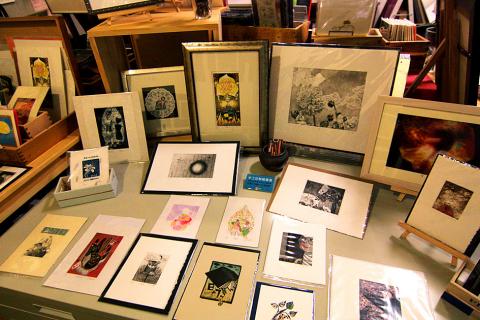
Photo: Catherine Shu, Taipei Times
Lovely Taiwan (台灣好,店)
Address: 18-2, Ln 25, Nanjing W Rd, Taipei City (台北市南京西路25巷18-2號)
Telephone: (02) 2558-2616
On the Net: www.lovelytaiwan.org.tw
Located next door to Booday, this modern, gallery-like space was opened two years ago by the Lovely Taiwan Foundation (台灣好基金會), which seeks to promote native Taiwanese culture. All of its reasonably priced items, which range from Aboriginal weavings to wooden animal carvings from Sanyi Township (三義鄉) in Miaoli County, are made by artisans or small workshops that maintain long-term business relationships with Lovely Taiwan.
Artale Workshop
Address: 32, Ln 42, Zhongshan N Rd Sec 2, Taipei City (台北市中山北路二段42巷32號)
Telephone: (02) 2568-2190; 0922-940-267
On the Web: artale-workshop.blogspot.com
Designer Hsu Chiu-i (徐秋宜) uses traditional Taiwanese indigo dyeing techniques to create motifs and patterns that look like abstract art. Artale carries accessories, embroidered totes and one-of-a-kind dresses by Hsu and her students. Other handmade items include jewelry, felted slippers and silk scarves.
ppaper shop
Address: B1, 2, Ln 26, Zhongshan N Rd Sec 2, Taipei City (台北市中山北路二段26巷2號B1)
Telephone: (02) 2568-2928
On the Net: www.wretch.cc/blog/ppapershop
Creative agency and magazine publisher ppaper operates a store that sells a variety of home and office accessories from around the world, design-related publications and ive&sean, the company’s own line of sleek, professional-looking maternity wear.
‘0416X1024
Address: 18, Ln 20, Zhongshan N Rd Sec 2, Taipei City (台北中山北路二段20巷18號)
Telephone: (02) 2521-4867
On the Net: www.hi0416.com
‘0416X1024’s colorful cotton T-shirts feature designer Liao Chen-hung’s (廖振宏) pen-and-ink illustrations, which mix sweet inspirational messages with a very wacky sense of humor. Fart jokes abound and Liao’s cartoon character roster includes hairy men sporting leather masks and G-strings. The store also sells small concrete lamps, vases and soap dishes by Robin Chen (陳榮彬), ‘0416X1024’s co-founder.
Chung’s Silver Work Studio
(玩銀工房)
Address: 2F, 10-1, Ln 20, Zhongshan N Rd Sec 2, Taipei City (台北中山北路二段20巷10-1號2樓)
Telephone: (02) 2531-9866
On the Net: www.chungsteam.com
Jewelry designer Chung Wei-wen (鍾維文) eschews electroplating in favor of laborious hand polishing, which gives all of his highly detailed sterling silver creations their signature soft, glowing luster. Many pieces are inspired by nature and motifs found in traditional Chinese art, while one-of-a-kind items include teapots forged entirely from silver with driftwood handles.
Twine Studio (繭裹設計)
Address: 8, Ln 20, Zhongshan N Rd Sec 2, Taipei City (台北市中山北路二段20巷8號)
Telephone: 0922-890-689
On the Net: www.twinestudio.net
Located in the fair-trade goods boutique Earth Tree (地球樹), Twine Studio was launched by former architects Elizabeth Tsai (蔡宜穎) and Vinka Yang (楊士翔). Original creations by the two combine modern, sculptural lines with natural materials like wool felt and dried leaves and seedpods. Twine Studio also sells fair-trade and earth-friendly products from local artists and international brands like UK-based Nkuku.
In Blooom (印花樂) and
Hakka Blue (台客藍)
Address: 1, Ln 32, Dihua St Sec 1, Taipei City (台北市迪化街一段32巷1號)
Telephone: (02) 2552-1338
On the Net: www.inblooom.com; www.hakka-blue.com, www.artyard.tw
The two brands share the ground floor of Art Yard (小藝埕), a three-story cultural center that is located in a former Japanese colonial era residence across the street from Yongle Market (永樂市場) on Dihua Street (迪化街). Scandinavian textiles inspire the crisp lines and soothing colors of In Blooom’s designs, while their motifs draw on Taiwan’s ecology and history. One group of fabrics, made into tote bags and cushions, features flora and fauna endemic to Taiwan, while another is based on ceramic tiles that were once a common feature in homes. Hakka Blue’s graceful pottery has colors taken from traditional Hakka indigo clothing.

June 2 to June 8 Taiwan’s woodcutters believe that if they see even one speck of red in their cooked rice, no matter how small, an accident is going to happen. Peng Chin-tian (彭錦田) swears that this has proven to be true at every stop during his decades-long career in the logging industry. Along with mining, timber harvesting was once considered the most dangerous profession in Taiwan. Not only were mishaps common during all stages of processing, it was difficult to transport the injured to get medical treatment. Many died during the arduous journey. Peng recounts some of his accidents in

“Why does Taiwan identity decline?”a group of researchers lead by University of Nevada political scientist Austin Wang (王宏恩) asked in a recent paper. After all, it is not difficult to explain the rise in Taiwanese identity after the early 1990s. But no model predicted its decline during the 2016-2018 period, they say. After testing various alternative explanations, Wang et al argue that the fall-off in Taiwanese identity during that period is related to voter hedging based on the performance of the Democratic Progressive Party (DPP). Since the DPP is perceived as the guardian of Taiwan identity, when it performs well,

A short walk beneath the dense Amazon canopy, the forest abruptly opens up. Fallen logs are rotting, the trees grow sparser and the temperature rises in places sunlight hits the ground. This is what 24 years of severe drought looks like in the world’s largest rainforest. But this patch of degraded forest, about the size of a soccer field, is a scientific experiment. Launched in 2000 by Brazilian and British scientists, Esecaflor — short for “Forest Drought Study Project” in Portuguese — set out to simulate a future in which the changing climate could deplete the Amazon of rainfall. It is

The Taiwan People’s Party (TPP) on May 18 held a rally in Taichung to mark the anniversary of President William Lai’s (賴清德) inauguration on May 20. The title of the rally could be loosely translated to “May 18 recall fraudulent goods” (518退貨ㄌㄨㄚˋ!). Unlike in English, where the terms are the same, “recall” (退貨) in this context refers to product recalls due to damaged, defective or fraudulent merchandise, not the political recalls (罷免) currently dominating the headlines. I attended the rally to determine if the impression was correct that the TPP under party Chairman Huang Kuo-Chang (黃國昌) had little of a